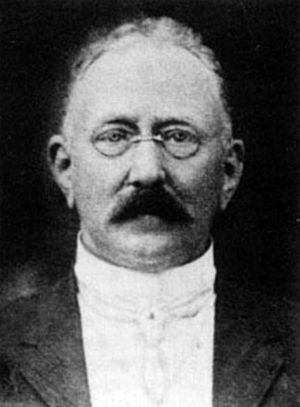J. W. B. Gunning facts for kids
Quick facts for kids
Jan Willem Boudewijn Gunning
|
|
|---|---|
 |
|
| Born | 3 September 1860 |
| Died | 26 June 1913 (aged 52) |
| Nationality | Dutch |
| Occupation | Physician |
Jan Willem Boudewijn Gunning (born September 3, 1860, in Hilversum, Netherlands – died June 26, 1913, in Pretoria, South Africa) was a Dutch doctor. He became famous for leading two important places in South Africa: the Staatsmuseum (which is now the Transvaal Museum) and the Pretoria Zoological Gardens (now called the National Zoological Gardens of South Africa).
Contents
Early Life and Education
Jan Willem Boudewijn Gunning was born in Hilversum, a town in the Netherlands. He was the second son of a well-known Dutch religious leader, Johannes Hermanus Gunning. Jan Willem studied medicine at several universities, including the University of Amsterdam, Leiden University, and Jena University. He worked hard and earned his degree as a doctor.
Moving to South Africa
In 1884, after finishing his studies, Gunning moved to South Africa. He started his medical practice in a region called the Orange Free State. That same year, he met and married Susanna Neethling. They got married on November 10, 1884. Sadly, Susanna passed away in 1889.
After some time in the Free State, Gunning moved to the Cape Colony and continued his work as a doctor there.
Leading Museums and Zoos
In 1897, Jan Willem Gunning was chosen for a very important job. He became the first director of the Staatsmuseum (State Museum) in Pretoria. This museum later changed its name to the Transvaal Museum. He stayed in charge of the museum until he passed away in 1913.
Gunning also played a key role in starting the National Zoo in Pretoria. He founded the zoo in 1899, which was a big step for animal conservation and education in South Africa.
Gunning During the Boer War
During the Second Boer War, Winston Churchill was held as a prisoner in Pretoria. He got to know Dr. Gunning well, as Gunning was one of the people in charge of the prison. Churchill described Gunning as a kind and educated man who loved his country's government. He also mentioned Gunning's passion for collecting stamps and starting the zoo.
Churchill shared a funny story about Gunning and the zoo:
Dr. Gunning was a friendly little Dutchman, a bit plump and well-educated. He was very interested in politics and loyal to the Boer Government, which paid him well to look after the State Museum. He had an amazing collection of postage stamps and was also busy creating a Zoological Garden. This last goal had caused him serious trouble just before the war, because he couldn't say no to a lion that Mr. Rhodes had offered him. He told me that the President had spoken very harshly to him about it and had ordered him to return the animal right away, threatening to fire him if he didn't.
Another prisoner, Captain Aylmer Haldane, also spoke highly of Gunning:
We were looked after by two officials. One was a Boer commander, and the other was a Dutch gentleman, Dr. Gunning. He was also in charge of both the Zoological Gardens and the Museum. The commander wasn't always the best, but the doctor was always polite and did everything he could to make our time as prisoners as comfortable as possible.
– Aylmer Haldane
Family Life
After his first wife, Susanna, passed away, Jan Willem Gunning married Ellen Elizabeth Dobbin on November 19, 1889. Ellen was from Bethulie and was born on December 30, 1867.
Contributions to Science
Gunning was not only a doctor and a museum director but also contributed to the study of animals, especially birds. In 1910, he worked with Alwin Karl Haagner to create A Checklist of the Birds of South Africa. This book helped people identify and learn about the different bird species in the region.
A specific bird species, the Sheppardia gunningi, is named after him. This bird is also known as the east coast akalat or Gunning's akelat. It's a special way to remember his contributions to ornithology, the study of birds.

